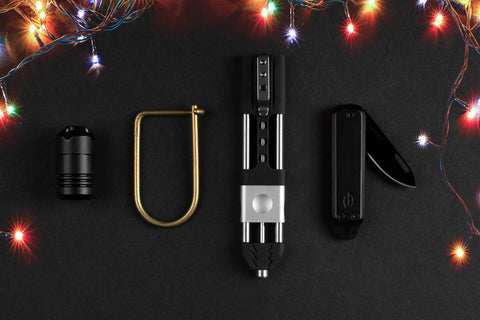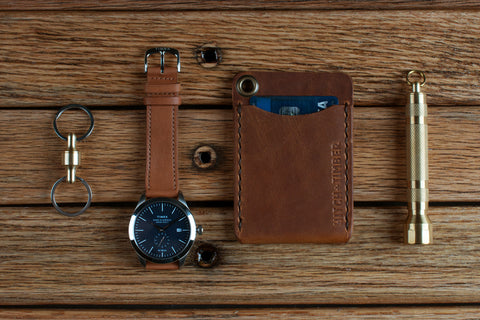Why You Should Always Carry A Flashlight

There are a vast number of distinguishing characteristics, discoveries, and inventions which separate humanity from the rest of the animal kingdom. Our capacity for complex thought and problem solving, for example, lead to the fashioning of simple tools. Which enabled us to pave the way toward the creation of society, culture, and - eventually - civilization as we know it. That path was marked by the advent of a myriad of innovations that without we could not have possibly made it this far. But there is one that stands out beyond all others: the ability to make fire.
Mastering fire gave humankind a tremendous advantage that we did not have prior; It gave us the capability to see in the dark. No longer were we relegated to the daylight hours under threat of danger and/or death. We were free to wander wherever and - more importantly - whenever we wished. In time, we learned to capture that illumination through the creation of torches, lanterns, street lamps, etc. Now, nights are illuminated by the glow of artificial sunlight in cities around the world. Still, we sometimes manage to find ourselves in the dark. And that is why we carry flashlights.
Brilliant Utility
The flashlight is perhaps the most overlooked of all the EDC categories. People tend to wonder why, in a world entrenched in municipal power grids and smart phones, should one bother weighing themselves down with something that seems so unnecessary? The short answer is: power will fail you. But it isn’t as simple as that. There are a wide variety of practical flashlight applications both occasional and daily that most people just don’t consider. So we have.
Outage
Hurricanes, tornados, earthquakes, tsunamis, fires, floods - you get the picture - can all knock out a power grid. And being trapped in the dark in a disaster zone can compound the danger exponentially. Even a non-emergency blackout can be risky, not to mention inconvenient, if you don’t have a flashlight handy.
Discovery
It doesn’t matter how many carrots you eat; you will never have natural night vision. And since you probably aren’t going to wear an infrared rig every time the sun goes down or you enter a dark room, having something to light your way can be indispensable. Sure, not every path is riddled with rocks and ruts, not every alleyway is dark and eerie, and not every item dropped under a desk or car is nigh impossible to find. Sometimes they are.
Conservation
If you are out camping, or your car breaks down, or your electricity to your home or work are for whatever reason disconnected, power becomes a very valuable and dwindling commodity. Since nothing sucks the juice out of a smart phone quite like the flashlight function, it’s better to have a dedicated tool and save your phone battery as a means to get in touch with your friends, family, emergency assistance, or even just a tow truck.
Convenience
Yes, most people carry around a phone charger or have one in their car or don’t need to use their flashlight function for an extended period of time. But it gets annoying to dig your phone out of your pocket, unlock it or scroll up the menu, turn on the light, do whatever you were trying to do, turn the light back off, lock your phone, and put it back in your pocket. Especially if you end up realizing you still need light. And you can forget about using two hands.
Functional Forms
The truth is, the usefulness of a flashlight in your everyday carry arsenal far outweighs the perceived drawbacks. Chances are you’ll find yourself using it much more than you ever anticipated and you’ll be better off for it. And if you’re still concerned about size, weight, power, modes, utility, or whatever else, there are dozens of options out there. All you have to do is figure out your particular needs and find one that suits them. Trust us, it’s out there. For a better understanding of what to look for, we’ve outlined some common terminology below.
Lumens: the metric used to describe the amount of light emitted. A higher number means a brighter light. For reference, a 100 watt bulb generally gives off around 1600 lumens. For normal daily use, 50-150 works great. For treks into the great outdoors, look for something closer to 1000.
Battery: the power source for any given flashlight. AAA alkaline tends to be the most common and easy, but alternatives such as lithium or NiMH are rechargeable and longer lasting.
Runtime: the total amount of time that a flashlight can function without needing to replace the battery. Be sure to pay attention to the small print. Often the listed runtime refers solely to the dimmest brightness mode.
Emitter: Pretty much across the board, EDC flashlights are equipped with an LED (Light Emitting Diode). This metric is intrinsically tied to the other three, as the specs of any emitter will determine lumens and runtime when combined with the battery type. While important, you can generally get an understanding of a flashlight’s emitter by paying attention to the other metrics.
Bright Ideas

Prometheus Lights Beta QRV2
The sturdy metal Beta-QRV2 was built by the talented, Mountain View-based crew at Prometheus Lights. Each EDC flashlight is equipped with a 55 hour run-time, three brightness settings, and a quick-release attachment for easy keychain removal. To ensure there's something for everyone, the keychain light is also available in 4 different finish options including black, bronze, copper and nickel.
![]()
Pixel Keychain Flashlight
One of the smallest keychain flashlights in the world, the Pixel takes up little more space than a standard metal key, weighs less than an ounce with batteries, and produces 25 lumens. The perfect everyday carry choice for those looking for something small and discrete.

Foursevens Bolt Mini
About the size of a standard ballpoint pen, the Bolt Mini is named for its unique bolt-action clicker. Developed by the team at Foursevens, this aircraft-grade aluminum flashlight also features 3 brightness modes and 5 possible configurations.

IllumineX-3 Keychain Flashlight
The Illuminex-3 is the world's smallest USB rechargeable flashlight - a feat in and of itself - but don't let its small size fool you. Despite its tiny package, each EDC light features an impressive 130 lumens. And when you need to re-juice your battery, the sturdy little keychain light can be fully charged in only an hour.

Peak LED Solutions Eiger
Not only is the Eiger a durable, high-quality, high-output everyday carry flashlight, but it is also compatible with a number of different battery chemistries. And while it might look your ordinary everyday flashlight, Peak LED Solutions' flagship model is one of the few flashlights still entirely manufactured and assembled in the USA - right from the brand's Phoenix, Arizona factory.
© Photography by Gallantry







